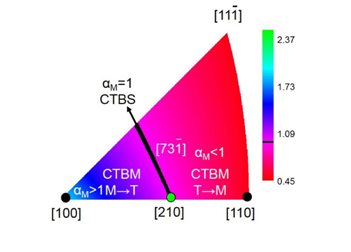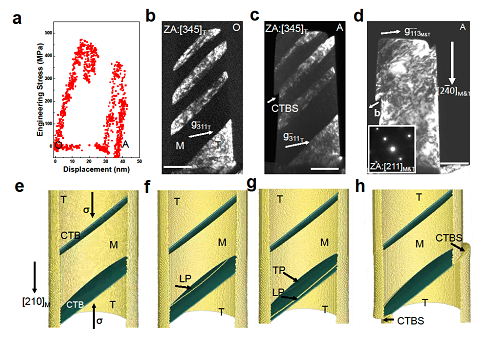Engineered nanoscale coherent twin boundaries (CTBs) offer an effective approach to achieve a good combination of high strength and reasonable ductility in materials. In order to optimize the properties of materials by tailoring the geometry and structure of CTBs, numerous studies have been carried out to elucidate the mechanisms of deformation involving CTBs. Twin boundary migration is so far the only experimentally observed mode of boundary motion involving twinned FCC metals. Therefore, it has been widely considered that CTBs cannot slide. Although occasional molecular dynamics, computational simulations point to the possibility of CTB sliding at low temperatures and under limited conditions, significant twin boundary sliding has not been experimentally documented so far.
Through theoretical analysis, we show quantitatively that CTB sliding should be possible at least for specific loading orientations and develop a general orientation map for CTB migration and CTB sliding. By recourse to in situ quantitative mechanical testing on nanotwinned copper pillars inside a transmission electron microscope (TEM), we demonstrated for the first time that CTBs can slide, validating our theoretical analysis and consistent with our quantitative predictions.

Orientation map for coherent twin boundary sliding and migration

In situ observation of coherent twin boundary sliding and its mechanism by molecular dynamics simulation
The findings establish, both experimentally and theoretically, the occurrence of significant CTB migration, contrary to generally accepted notion. They also add new mechanistic insights to the deformation mechanisms of CTBs which is topic of considerable and growing interest in the literature within the past decade. In addition to its general scientific interest, the present results are expected to offer valuable insights into ways in which the design of micro- and nano-structures involving CTBs could be accomplished so as to optimize material properties and performance.
This work has been published on Nature Communications http://www.nature.com/articles/s41467-017-01234-8. The authors include Dr. Zhangjie Wang, PhD candidate Yao Li and Longchao Huang, Prof. Zhiwei Shan in CAMP-nano, PhD candidate Qingjie Li and Prof Evan Ma in Johns Hopkins University, Prof. Lei Lu in Institute of Metal Research of Chinese Academy of Sciences, Dr. Ming Dao and Prof. Ju Li in Massachusetts Institute of Technology, Prof. Subra Suresh in Nanyang Technological University.
This work was supported by the Natural Science Foundation of China (51231005, 51401159, and 51621063), the 973 Programs of China (2012CB619402), and the 111 project (B06025).
Read the paper here: http://www.nature.com/articles/s41467-017-01234-8


